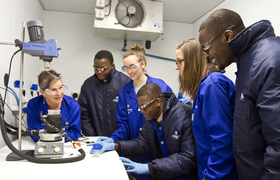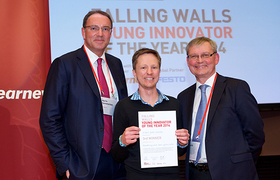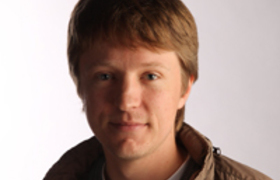Greenovate Award for student’s recycled-urine project
01 December 2017 | Story Helen Swingler, Dyllon Randall. Photos Robyn Walker.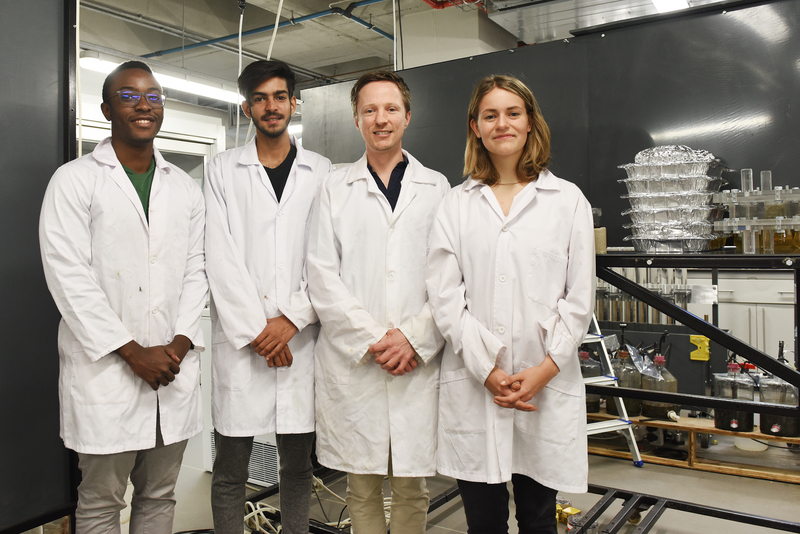
Houses built with bio-bricks made from urine? Waterless urinals feeding home-based fertiliser factories? Four final-year civil engineering projects are showing the way in a future of increasing water scarcity. And one of these, Craig Flanagan’s fertiliser-from-urine venture, bagged a prestigious Greenovate Award – and R30 000 – in Johannesburg last night.
The Greenovate Awards spotlight sustainable research in buildings. The competition is open to final-year property, building, surveying, construction and engineering students.*
Together, the UCT students’ projects demonstrate the benefits of introducing waterless urinals that not only save vast quantities of water from going down the tubes, but recover valuable, sustainable resources from what project leader Dr Dyllon Randall calls “liquid gold”.
That precious commodity is nothing other than urine.
Two of the projects, bio-bricks made from urine, and a fertiliser-making urinal, were nominated for the 2017 Greenovate Awards.
Super-bowl challenge
The underlying ideas for the projects had been incubating for some time.
An alumnus and now senior lecturer in civil engineering, Randall spent two years at the Swiss Federal Institute of Aquatic Science and Technology on the Reinvent the Toilet Challenge, funded by the Bill and Melinda Gates Foundation.
“It was about redesigning the toilet with a focus on developing countries. The idea was that a toilet should be self-sufficient; it shouldn’t need to be connected to a sewage system. We should treat our ‘waste’ within the toilets and recover value from them.”
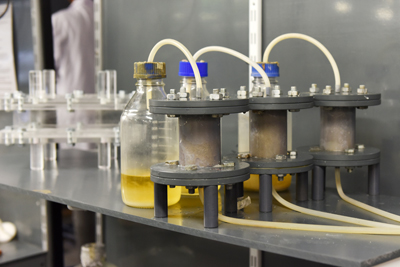
Trained as a chemical engineer, Randall has always been interested in resource recovery from wastewater. His PhD at UCT was in the field of eutectic freeze crystallisation, a process that reclaims value from acid mine water.
But the stint in Switzerland got him thinking hard about what could be done with urine in a water-scarce region where urinals can use up to three litres of fresh water with each flush and modern dual toilets up to six litres per flush.
“This equates to between 20 and 30% of the recommended daily water usage in Cape Town. That’s crazy.”
In Switzerland, he’d focused on recovering fertiliser from urine and this sparked the idea of possibly using the urea present in urine to make bio-bricks through a natural process called microbial carbonate precipitation. Back in South Africa, and newly employed at UCT in February this year, he approached the Water Research Commission to fund a one-year feasibility study. (The commission has just extended funding for another two years.)
He put the ideas to four final-year civil engineering students – Craig Flanagan, Suzanne Lambert, Bilaal Kowdur and Tinashe Chipako – for their research project.
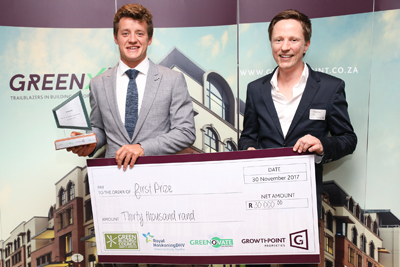
Urine, urine, everywhere
Flanagan’s Greenovate award-winning project investigated the on-site production of fertiliser from a waterless urinal installed in the New Engineering Building. He designed and constructed a ‘temporary’ urinal housing calcium hydroxide, which produces calcium phosphate when urine collects in the container.
The odour usually associated with stored urine was solved by manipulating pH levels with calcium hydroxide. This allowed for long usage and storage times.
From one urinal, Flanagan collected 100 litres in 22 days. The solid fertiliser that had collected in the bottom yielded 11 grams of fertiliser per kilogram of urine collected. The urinal recovered over 97% of the phosphorus present in the urine as calcium phosphate – phosphate is a key ingredient in fertilisers that underpin commercial farming worldwide.
This is significant because natural phosphate reserves are running dry.
“Some researchers predict that we’ll reach ‘peak phosphorus’ in the next 50 years,” says Randall.
But the remainder of the urine didn’t go down the toilet. In the lab, it was siphoned to Lambert who produced a novel building product that could revolutionise the brick-making industry.
Grow a brick
The process is not unlike the way seashells are formed.
Loose sand is colonised with bacteria that produce urease. An enzyme, the urease breaks down the urea in urine while producing calcium carbonate through a complex chemical reaction. This cements the sand into any shape: a solid column, or a brick, for example.
“The bio-solids typically have the same compressibility strength as conventional 40% limestone bricks.”
The concept was tested in the US some years back using synthetic urea solutions, but Lambert made a solid column using real human urine for the first time. Her work continued from the foundational work conducted by Jules Henze, a Swiss student who spent four months working with Randall on this concept.
“The bio-solids typically have the same compressibility strength as conventional 40% limestone bricks,” says Randall. “Suzanne’s next step will be to make an actual brick [shape] using this process.”
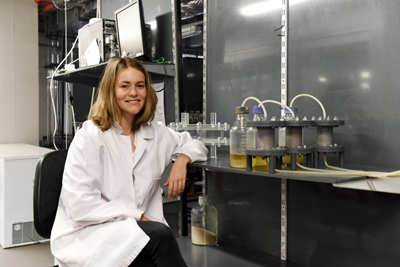
Solid from liquid
Unlike regular bricks, which are kiln-fired at temperatures around 1 400oC and produce vast quantities of carbon dioxide, bio-bricks are made in moulds at room temperature. The longer the curing process, the stronger the brick.
But there’s more: by-products of the bio-brick process are nitrogen and potassium, two additional key ingredients in commercial fertilisers.
Chemically speaking, urine is liquid gold. It makes up less than 1% of domestic wastewater (by volume) but contains 80% of the nitrogen, 56% of the phosphorus and 63% of the potassium of this wastewater.
“We literally pee away these valuable nutrients every day,” says Randall.
The process has been eye-opening, says Lambert. She started by growing her own bacteria for the mould, which took some time. During the pilot project, her reactor leaked and only the bottom half of the bio-brick solidified.
“So, I started again. That was my pilot run so at least I know solidification happened, and that was encouraging. The happiest I’ve been was when I opened the reactor and there was solidification! All along I’d been thinking, I’m crazy, there’s nothing happening … So that was great.”
Jerry cans and plastic funnels
Kowdur’s work on nutrient-recovery urinals was similar to Flanagan’s. However, he also tested the feasibility and social acceptance of the fertiliser-producing urinals at a household level.
To do this he installed 10 makeshift urinals created from jerry cans and plastic funnels, at an off-campus residence. These urinals also contained calcium hydroxide to facilitate the fertiliser production. The challenging part was constantly maintaining the urinals, checking for leaks, and agitating the contents as often as possible.
Once full, Kowdur transported the jerry cans to the campus laboratory, which acted as a resource recovery plant for the fertiliser production. He collected 110 litres of urine in 30 days, with a fertiliser production rate of 17.5 grams per kilogram of urine collected.
Importantly, Kowdur’s research showed that all the users were happy to use a device like this in the future.
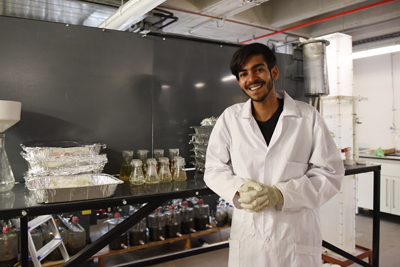
Olympic-pool-sized savings
Chipako’s project took Kowdur and Flanagan’s concept a step further. He researched the feasibility of installing waterless urinals on upper campus. He showed that UCT uses the equivalent of about seven Olympic-sized swimming pools annually just to flush urinals.
“Level 5 water restrictions suggest that a urinal should be flushed a maximum of three times a day. Yet it’s estimated that urinals are flushed 75 times a day at UCT,” says Chipako.
Chipako also found that UCT uses about three tons of fertiliser for its sports fields every year. However, the university has the potential to produce six tons just from the urine collected in its urinals.
The project stretched his skills in new ways. He not only got into the nitty gritty of the various quantities and costings, but he also surveyed the UCT community. Would they use waterless urinals and would they be willing to eat food using urine-derived fertilisers? A resounding 95% of his 500 respondents ticked the box for waterless urinals. And 79% said they would eat food grown from urine-derived fertilisers.
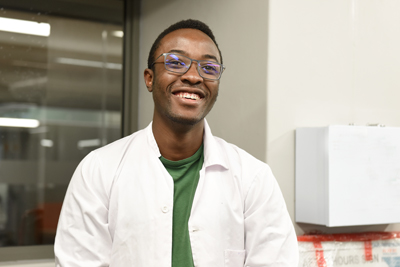
Drying up from the south
As the southern hemisphere becomes drier, projects like these point to the urgency of revamping sanitation systems to reduce the water load and produce valuable by-products from a renewable resource, says Randall.
Even retro-fitting homes and places of work with waterless and resource-recovery urinals would go a long way to saving water.
And by tweaking existing recycling collection and processing systems to collect the vast quantities of valuable urine flushed away, we could reap the benefits of sustainable fertilisers − and sustainable products like bio-bricks.
Having lived in Switzerland for two years, Randall has seen how seriously Europe is taking this.
“Realising the world is running out of phosphorus, Switzerland and Germany have passed legislation where by law they have to start recovering phosphorus. The sooner we start doing this, the better.”
Next up for the researcher is a device that harnesses electricity from bacteria, plants and sewage.
But that’s a story still in the making.
(*There were further Greenovate Awards for UCT students, which will appear in a follow-up story.)
 This work is licensed under a Creative Commons Attribution-NoDerivatives 4.0 International License.
This work is licensed under a Creative Commons Attribution-NoDerivatives 4.0 International License.
Please view the republishing articles page for more information.







